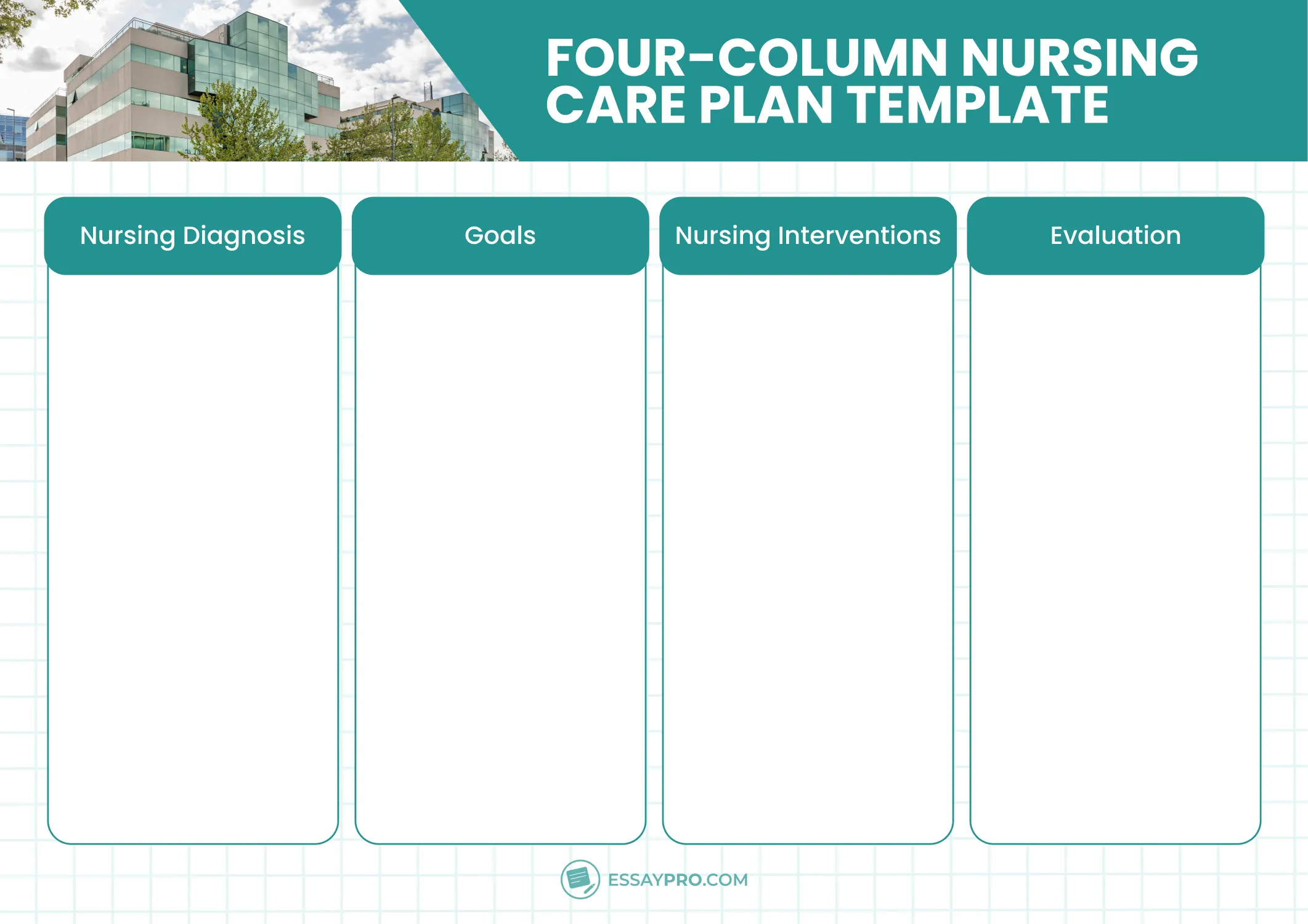A nursing care plan is a structured guide that directs how nurses manage patient care. It identifies key nursing issues and establishes measurable goals, then maps out specific nursing interventions to meet those goals. A full plan includes assessment data, a nursing diagnosis, expected outcomes, nursing interventions, and evaluation of progress toward those outcomes.
This article provides sample nursing care plans in PDF format, so students can better understand and apply the nursing process.
If you need further help with your assignments, EssayPro provides essay services to help you create clear, goal oriented papers!
Feeling lost in NCPs? Ask for help with your care plan outline inside our nursing forum.


What Is a Nursing Care Plan?
Nursing care planning is a document that organizes important details about a patient’s condition and treatment goals. It defines the nursing diagnosis and lists the steps needed to reach the expected outcomes. Each plan records observations and evaluation notes that show how the patient responds to care. Nurses update it during every shift to reflect any changes in patient's health status, keeping care accurate and aligned with the patient’s needs.
Purposes of a Nursing Care Plan
The primary purpose of a nursing care plan is to give nurses an outline of what a patient needs and how that care should be delivered. Beyond that main goal, writing a nursing care plan serves several other important purposes:
- It helps nurses think through each step of care before acting, so decisions are based on logic rather than guesswork.
- It keeps all nurses on the same page during shift changes, reducing the chance of mistakes or repeated work.
- It improves communication between nurses, doctors, and other healthcare providers who share responsibility for the patient.
- It helps staff notice changes in the patient’s condition faster and make adjustments to treatment when needed.
Many learners use templates or reach out to nursing paper help services to ensure their care plans meet both academic and clinical standards.
Types of Nursing Care Plans
Care plans can be classified along two dimensions: formal vs informal, and standardized vs individualized. Creating a nursing care plan starts with figuring out which of those types best fits the situation at hand. In the following sections, we’ll see the differences between formal vs. informal and standardized vs. individualized plans.
Formal vs. Informal
First, let’s look at the differences between formal and informal nursing care plans. The difference lies in how the plan is documented and used during patient care.
- Formal care plans are the detailed written or digital versions used for ongoing treatment. These documents include essentials: the patient’s health issues, the nurse’s goals, and detailed steps to get there.
- Informal care plans are the quick mental checklists nurses keep in their heads during a shift. They aren’t written down and documented anywhere. For example, a nurse might think, ‘I’ll remind Mr. Lee to move more after lunch’.
Standardized vs. Individualized
Now, let’s understand how standardized plans differ from individualized ones. In short, the main distinction between those two is how specific the plan is to each patient.
- Standardized care plans are templates that fit clients with similar health problems. They combine goals and interventions that will work in most cases. It could be maintaining vital signs, preventing infections, etc. These types of plans help hospitals save time and keep the care consistent.
- Individualized care plans are created for one particular case/person. They include the specific needs, conditions, interventions, and goals. Say two patients both have pneumonia, but one patient also suffers from asthma. In this case, a nurse will adjust the care plan that will include breathing support for the patient with asthma.
Components of a Nursing Care Plan
Most student nursing care plans follow five core elements: assessment, diagnosis, expected outcomes, interventions, and evaluation.
Nursing Care Plan Format
There’s no one “correct” nursing care plan template; the format depends on how much detail is needed. Students can opt for the following options: three, four, five, and six-column formats. Here’s what each includes:
Three-Column Format
This one is the easiest among nursing care plan formats. It’s quick to write and great for practice while still learning the basics. The three-column format includes these components: nursing diagnosis, desired outcomes, interventions.

Four-Column Format
The four-column version adds one more step, which is evaluation. It records how the patient responded to care. Maybe their pain went down, maybe it didn’t. Writing that out helps decide what to do next.
The four-column format includes these components: nursing diagnosis, desired outcomes, interventions, evaluation.

Five-Column Format
Here, nurses add an assessment column to capture what they noticed before setting goals.
The five-column format includes these components: nursing diagnosis, desired outcomes, interventions, evaluation, assessment.

Six-Column Format
This one’s the full version used in most hospitals. It takes more time to fill out, but it paints a clear picture of the patient’s care from start to finish.
The six-column format includes these components: nursing diagnosis, desired outcomes, interventions, evaluation, assessment, rationale.

If you’re planning your career in healthcare leadership, read our article on healthcare management salary entry-level to map out your professional growth path.
Writing a Nursing Care Plan
Writing a care plan begins by gathering and interpreting patient data. Next comes identifying nursing diagnoses and setting priorities. Then nurses establish goals, choose interventions, provide rationales, and evaluate outcomes.
The next sections explain these steps in order.
1. Collect and Assess Patient Data
Writing a nursing care plan starts here. Before planning anything, nurses have to analyze numbers, facts, feelings, and see beyond what’s written in the chart.
Nurses will gather both subjective and objective data. Subjective data includes what the patient tells about their health problems, like pain, fatigue, appetite, etc. As for the objective data, nurses include measurable details such as vital signs, lab results, and verifiable observations.
Many students entering care-plan assignments first wonder how long is a nursing school. If you’re also curious, read our article.
2. Organize and Interpret the Collected Information
Nurses go through notes, test results, and observations. Group what belongs together, such as pain reports, medication responses, lab values, and everything else that seems relevant. If the patient’s oxygen level dropped after a certain medication, that link is important.
Many nurses use electronic systems like Epic’s flowsheets or NANDA-I diagnosis tools to help sort data, but intuition still plays a part. During this step, it’s easy to see cause-and-effect relationships and figure out what’s normal for this patient and what isn’t.
3. Formulate Nursing Diagnoses
Nurses have gathered notes, checked charts, and talked with the patient. Now they have to name what’s happening in a way that makes sense for nursing care.
A nursing diagnosis explains how the patient is responding to what’s happening with their health. For example, a patient with heart failure might experience activity intolerance due to tiring easily or fluid volume excess, as evidenced by swollen legs. Those are areas nursing care can actually target.
Nurses usually follow a pattern: problem, cause, and evidence. But don’t get stuck on the format. What matters is accuracy. If it feels too scripted, go back and look at the patient again.
4. Set Priorities for the Identified Problems
Now that nurses have diagnoses, they have to decide what comes first, because they can't handle everything at once, and that’s okay.
Look at the patient, not just the paper. If they’re short of breath, that jumps to the top of the list. If they’re anxious or in pain, that’s next in line. The order changes depending on what’s happening in front of the nurses.
5. Establish Client Goals and Desired Outcomes
Once nurses have identified what’s wrong, the next step is to figure out what better looks like. To write a nursing care plan, nurses can follow two frameworks. The first is SMART, and it’s probably the most recognized method in nursing schools and hospitals today. The alternative framework is REEPIG (Realistic, Explicit, Evidence-based, Prioritized, Involve[d], Goal-centred) which builds on SMART by adding emphasis on prioritization and involvement.
SMART goals keep care plan practical:
- Specific
- Measurable
- Attainable
- Relevant
- Time-bound
REEPIG goals sharpen things even more:
- Realistic
- Explicit
- Evidence-based
- Prioritized
- Involved
- Goal-centered
6. Select Appropriate Nursing Interventions
Goals are written, and now nurses decide what actions will move the patient toward them. The main goal is to match the action to the goal.
Being specific about what will happen and how often is important. Nurses should describe who will carry it out and how they’ll track the results. The stronger the plan, the smoother the shift runs. It’s less about filling boxes and more about creating steps that actually make a difference for that one person.
7. Provide Rationale for Each Intervention
A rationale in a nursing care plan is the explanation for why a specific nursing action or intervention is chosen.
For example:
Intervention: Encourage the patient to take deep breaths every hour.
Rationale: Deep breathing helps expand the lungs and improve oxygen exchange.
A proper rationale should be based on evidence, connected to outcomes, simply phrased, reflective.
8. Evaluate the Patient’s Progress
Most of the comprehensive nursing care plan formats include this step. This is where it’s determine if the plan has worked.
Nurses start with what they can see. Compare the patient’s current state with the goals written earlier. Did the wound close faster than expected? Is the pain scale lower?
If something worked, continue doing it, and if progress is slow, change the plan. Add new interventions, adjust the timing, or set a new goal altogether. Nothing in nursing stays static; the patient keeps changing, so the plan should too.
A few nurses write down notes right after the shift, while others update in digital tools. It doesn’t matter how they do it; they should just make sure the record is clear enough for the next nurse to pick up right where they left off.
It should be written as if talking to a colleague:
'Patient reports sleeping through the night for the first time this week. Will continue current pain management routine.'
Nursing Care Plan Examples
Below are examples of three-column, four-column, five-column, and six-column nursing care plans. These free nursing care plan examples are built on the same idea but add more depth and structure.
Three-Column Nursing Care Plan
Keep it simple. This format works best for beginners or short-term cases. Focus on clarity and direct links between diagnosis, goals, and actions.
Four-Column Nursing Care Plan
Use this format to track progress. The added evaluation column helps record changes quickly and make adjustments without rewriting the whole plan.
Five-Column Nursing Care Plan
Nurses add assessment data here to strengthen reasoning. This version gives context to every diagnosis and helps them connect what they see to what they plan.
Six-Column Nursing Care Plan
This one is built for detail. Include rationales for each intervention and note how the patient responds over time. Hospitals and advanced courses often use this version because it shows full clinical thinking from start to finish.
Tips for Effective Care Planning
Effective nursing care planning means patient centered care. It starts with a thorough assessment, followed by clear, patient-focused goals that guide every step of care. The most effective strategies include respecting patient preferences, keeping communication open across the care team, documenting each update, and building on the patient’s existing strengths rather than focusing only on limitations.
Here are a few ways to make nursing care plans stronger and easier to follow:
- Start with the patient’s story. Understanding what matters most to the patient makes every goal more relevant and personal.
- Set realistic goals. Achievable goals build trust and confidence for both the nurse and the patient.
- Use clear, simple language. Write as if someone new will read your plan mid-shift.
- Collaborate with the team. Talk with other healthcare providers and update the plan together.
- Review and update often. A care plan isn’t permanent. As conditions change, the plan should too.
- Document everything. Write down what happened and why. Good records protect both the patient and the nurse.
- Reflect on outcomes. After each case, take a moment to see what worked and what didn’t.
Those planning care for aging patients often compare different care settings, such as nursing home vs assisted living, to better understand patient needs and discharge options.
The Bottom Line
A nursing care plan brings order to a process that can otherwise feel chaotic. It guides nurses, aligns teams, and helps patients understand their progress. From assessment to evaluation, each step ensures that care is structured, measurable, and meaningful. Learning to document care clearly also strengthens a nursing student resume for clinical placements or entry-level roles.
If you need help translating the nursing process into written form, EssayPro can assist. Whether you’re preparing a care plan paper or a full research project, our writers can help you express clinical reasoning clearly and professionally.
FAQs
What is a Nursing Care Plan?
A nursing care plan is a personalized guide that outlines the nursing care to be provided to a patient. It details the patient's health status, their specific healthcare needs, and the actions nurses will take to meet those needs.
What are the 5 Main Components of a Care Plan?
The main components of a care plan typically include:
- Assessment: Gathering information about the patient's health status.
- Diagnosis: Identifying the patient's specific health issues or needs.
- Planning: Setting measurable goals and determining the interventions needed.
- Implementation: Putting the care plan into action by delivering the planned interventions.
- Evaluation: Assessing the effectiveness of the care provided and making adjustments if necessary to achieve the desired outcomes.
How to Do a Nursing Care Plan?
To create a nursing care plan, nurses assess the patient's health condition, identify their needs, set goals for improvement, plan specific interventions (like medications or therapies), and evaluate outcomes to adjust the plan as needed. It's a structured approach to ensure patients receive effective and individualized care.
What Does a Nursing Care Plan Look Like?
A nursing care plan is usually organized as a table or chart that includes the patient assessment, nursing diagnoses, goals, interventions, and evaluation. Depending on the format, it may use three, four, five, or six columns.
Why Nursing Care Plan Is Important?
A nursing care plan keeps care consistent, safe, and patient-centered. It helps nurses prioritize actions, communicate effectively across teams, and evaluate whether interventions achieve the desired outcomes.

Adam Jason
is an expert in nursing and healthcare, with a strong background in history, law, and literature. Holding advanced degrees in nursing and public health, his analytical approach and comprehensive knowledge help students navigate complex topics. On EssayPro blog, Adam provides insightful articles on everything from historical analysis to the intricacies of healthcare policies. In his downtime, he enjoys historical documentaries and volunteering at local clinics.
- Western Governors University. (2021, November 11). Nursing care plans: An introduction. https://www.wgu.edu/blog/nursing-care-plans-introduction2111.html
- Australian Commission on Safety and Quality in Health Care. (2021). Components of a comprehensive care plan: Information for clinicians. https://www.safetyandquality.gov.au/publications-and-resources/resource-library/components-comprehensive-care-plan-information-clinicians
- Nova Scotia College of Nursing. (n.d.). Care plan. https://www.nscn.ca/professional-practice/practice-support/practice-support-tools/care-plan




%20(1).webp)

